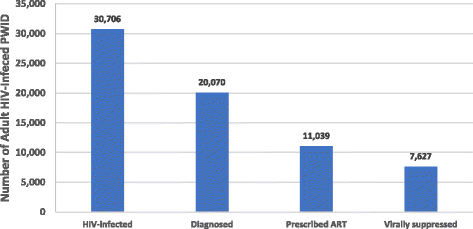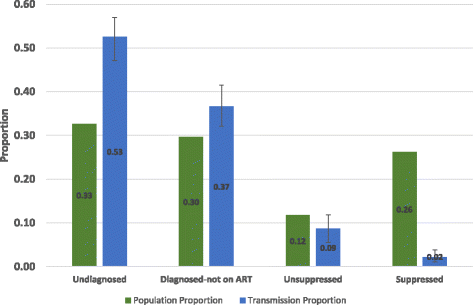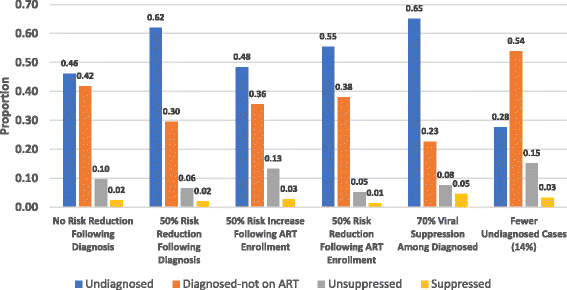The risk of HIV transmission at each step of the HIV care continuum among people who inject drugs: a modeling study
- PMID: 28738861
- PMCID: PMC5525346
- DOI: 10.1186/s12889-017-4528-9
The risk of HIV transmission at each step of the HIV care continuum among people who inject drugs: a modeling study
Abstract
Background: People who inject drugs (PWID) are at continued risk for HIV in the U.S., and experience disparities across the HIV care continuum compared to other high-risk groups. Estimates of the risk of HIV transmission at each stage of the care continuum may assist in identifying public health priorities for averting incident infections among PWID, in addition to transmissions to sexual partners of PWID.
Methods: We created an agent-based model simulating HIV transmission and the HIV care continuum for PWID in New York City (NYC) in 2012. To account for sexual transmission arising from PWID to non-PWID, the simulation included the entire adult NYC population. Using surveillance data and estimates from the National HIV Behavioral Surveillance system, we simulated a dynamic sexual and injecting network. We estimated the proportion of HIV transmission events attributable to PWID in the following categories, those: without an HIV diagnosis ('Undiagnosed'); diagnosed but not on antiretroviral therapy (ART) ('Diagnosed - not on ART'); those who initiated ART but were not virally suppressed ('Unsuppressed'); and, those who achieved viral suppression ('Suppressed').
Results: We estimated HIV incidence among PWID to be 113 per 100,000 person-years in 2012, with an overall incidence rate for the entire adult NYC population of 33 per 100,000 person-years. Despite accounting for only 33% of the HIV-infected PWID population, the Undiagnosed were associated with 52.6% (95% simulation interval [95% SI]: 47.1-57.0%) of total transmission events. The Diagnosed - not on ART population contributed the second-largest proportion of HIV transmissions, with 36.6% (95% SI: 32.2-41.5%). The Unsuppressed population contributed 8.7% (95% SI: 5.6-11.8%), and Suppressed 2.1% (95% SI: 1.1-3.9%), relatively little of overall transmission.
Conclusions: Among PWID in NYC, more than half (53%) of transmissions were from those who were unaware of their infection status and more than 36% were due to PWID who knew their status, but were not on treatment. Our results indicate the importance of early diagnosis and interventions to engage diagnosed PWID on treatment to further suppress population-level HIV transmission. Future HIV prevention research should focus on the elimination of identified and potential barriers to the testing, diagnosis, and retention of PWID on HIV treatment.
Keywords: ART; HAART; HIV care cascade; HIV care continuum; People who inject drugs.
Conflict of interest statement
Ethics approval and consent to participate
Not applicable.
Consent for publication
Not applicable.
Competing interests
The authors declare that they have no competing interests.
Publisher’s Note
Springer Nature remains neutral with regard to jurisdictional claims in published maps and institutional affiliations.
Figures



References
-
- Centers for Disease Control and Prevention. HIV Surveillance Report, 2015; vol. 27. http://www.cdc.gov/hiv/library/reports/surveillance/. Accessed 30 May 2017.
MeSH terms
Grants and funding
LinkOut - more resources
Full Text Sources
Other Literature Sources
Medical

